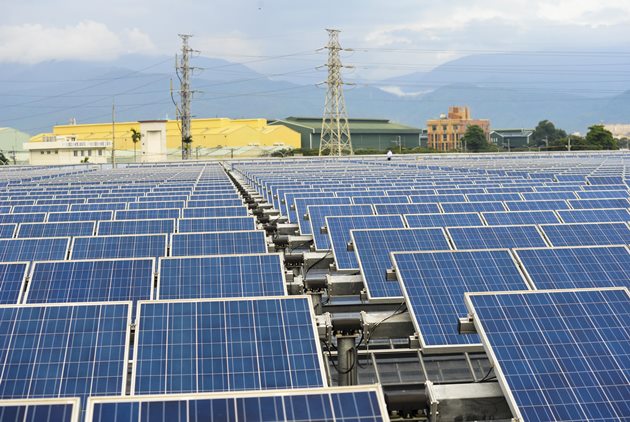In 2020, Taiwan’s Green Energy Will Power Tech Giants Like Apple and Google

Source:Kuo-Tai Liu
Rising demand from global supply chains for renewable energy has increased investment from various Taiwanese parts suppliers into green power. The enactment of environmental laws and the decrease in green energy costs both point to the possibility that 2020 will be the year when the Taiwanese renewable energy industry begins to grow exponentially.
Views
In 2020, Taiwan’s Green Energy Will Power Tech Giants Like Apple and Google
By Kwang-Yin LiuFrom CommonWealth Magazine (vol. 688 )
2020 will be the beginning of a new era in Taiwan’s industry of renewable energy. Carbon reduction is more than a buzzword, it’s what the market wants. International brands like Google and Apple have already made the promise to only use green energy. As part of their global supply chains, Taiwanese companies are also scrambling to go green.
The effort to reduce carbon emissions has moved from the fringe to become mainstream. As global tech giants such as Apple and Google demand their supply chains also use green energy, Taiwanese companies are all scrambling to find a sustainable source of renewable power.
The history of renewable energy in Taiwan has gone through many phases. A few years ago, it was all about the competitive price of green power (綠色電價). In 2017, the debate evolved to include the creation of a trading platform for Renewable Energy Certificates (再生能源憑證). But the biggest change will come in 2020. Green energy, which used to be bound to the Taiwan Power Company’s (台灣電力公司; Taipower) wholesale contract, will now be tradeable in the free market under certain conditions.
“2020 will be the year when Taiwan’s renewable energy market really takes off,” says Chih-Wen Huang (黃志文), Director of the National Renewable Energy Certification Center (國家再生能源憑證中心; T-REC).
Currently, companies hungry for green energy cannot even buy what they need. According to the Ministry of Economic Affairs, the total demand for renewable energy from Taiwanese businesses is around one billion kilowatt hours. In 2020, this number will increase to three billion.
But some Taiwanese companies are even more ambitious than that. Semiconductor giant TSMC’s 5nm and 3nm production facilities, as well as its research base in Hsinchu, are all committed to using green energy to make up for twenty percent of their overall power consumption. That’s the equivalent of 1.5 billion kilowatt hours. (Read: The World's Most Sustainable Enterprises are Long-lived - TSMC Makes it into the Top Ten)
Taiwan currently produces around 2.5 billion kilowatt hours of renewable energy annually. This number is expected to double in 2020. The challenge lies in how to bring every stakeholder to the table and iron out a system of distribution that satisfies everyone. Hopefully, a more detailed plan will be available after the Chinese New Year in 2020.
Why the sudden rush to step up production? Part of the pressure comes from big global customers, and part of the pressure comes from government regulations and Environmental Impact Assessments.
As Tech Giants Go Green, Suppliers Must Step Up Their Game
Taiwan is intimately connected with the global manufacturing supply chain. Tech giants such as Google and Apple have thrown in their lot with “RE100”, the business initiative launched by non-profit organization The Climate Group. They’ve made commitments to consume only renewable energy. The onus is now on suppliers, such as those in Taiwan, to use green energy.
Amanda Corio, Principal of Energy & Global Infrastructure at Google, makes her case for green energy in a 2019 conference about Renewable Energy Certificates. She says Google has three principles about how they purchase green power. One, energy and certification must be purchased together. Two, the energy must be generated by local power grids. And three, the energy must be purchased directly from its provider.
In other words, in order to have your green energy recognized by a global tech giant such as Google, it must be generated near one of its massive data centers, instead of being purchased in the form of a certificate from another region.
For example, Google announced in early 2019 that it would purchase 10 megawatts of renewable energy in Tainan to power its data center. This makes Google the first company to purchase renewable energy in Taiwan after the Electricity Act was amended. The amount purchased is not a lot, but the symbolic meaning is significant.
However, it’s not enough that the green energy is produced locally. International brands also expect the price to be competitive.
Another big buyer is Apple. According to Wang Shang-hai, Senior Manager in the Apple Clean Energy Team (蘋果潔淨能源組資深經理王上海), the average cost of generating renewable energy around the world is already low enough to match coal power. There’s no reason why the price should go higher. Global businesses also want the cost of green power in Taiwan to be competitive. Which is to say, it should not be too much different from the current cost of commercial power.
But some time will be needed to bridge the gap. At the moment, the Bureau of Energy puts the lowest wholesale purchase rate of solar power at 4.1 Taiwan dollars. That is still sixty percent higher than the average rate of commercial power, which is 2.5 dollars.
Big Users Should be Required to Support Green Power
The government’s contribution to the push for green energy is the amendment to the “Renewable Energy Development Act” (再生能源發展條例修法). Though the details won’t be ready until the first quarter of 2020, the broader strokes of the plan are already clear. Within five years, major power users must build renewable power plants that can provide ten percent of the energy they consume. When the time comes, more than three hundred petrochemical, steel, semiconductor, panel, and electronics manufacturers will have to come together and think of a way to turn one-tenth of their power consumption “green”.
Besides building renewable energy generators or storage facilities, companies can also purchase Renewable Energy Certificates, or even donate to a fund that facilitates the development of renewable energy.
Sources say the buying and selling of green power will follow the principle of “private first, Taipower second” (先民間後台電). Private renewable energy companies will always have priority when selling to the market. Taipower is only there as back-up. If there is not enough green power to sell, Taipower will tap into their unlimited pool of renewable energy to make up the difference, but they will never compete with private sellers.
As for the price, which is of paramount importance to businesses, the Ministry of Economic Affairs is inclined to prioritize the selling of cheaper green energy, including land-based wind power and cost-competitive solar power.
For instance, the Mingus Solar Project (台灣艾貴義竹發電廠) is a 70-megawatt power plant built by Vena Energy (韋能能源) in Chiayi. It is the largest private land-based solar power plant in Taiwan. Back when Vena won the tender in 2017, each kilowatt hour cost only 2.6 Taiwan dollars, which is almost the average price of commercial electricity. This record-breaking low price was a gamechanger in the industry.
But the industry is predicting that the next big boom of truly competitive renewable energy will come after 2025. Once large numbers of offshore wind turbines go online, the price of wind power will be as competitive as 2.2 to 2.5 dollars per kilowatt hour, which is lower than the price of commercial electricity.
Taiwan may have been slow to start its development of green power. But carbon reduction is a global trend, and big brands are asking their supply chains to step up. 2020 will be the year when past expectations are exceeded and we get a glimpse at the future of renewable energy.
【More on energy transition in Taiwan】
♦ Air Pollution or Nuclear Power?
♦ Tug-of-War Between Time and Pollution
♦ Phasing out Nuclear Power? An Interview with Minister of Economic Affairs
Translated by Jack C.
Edited by Sharon Tseng












